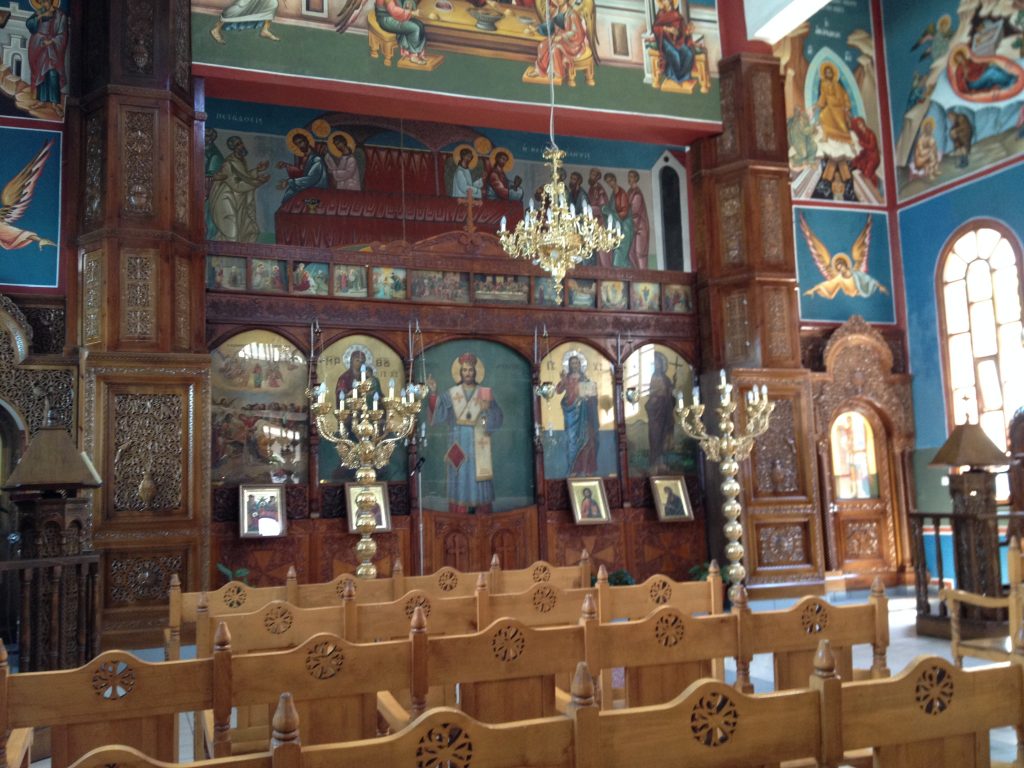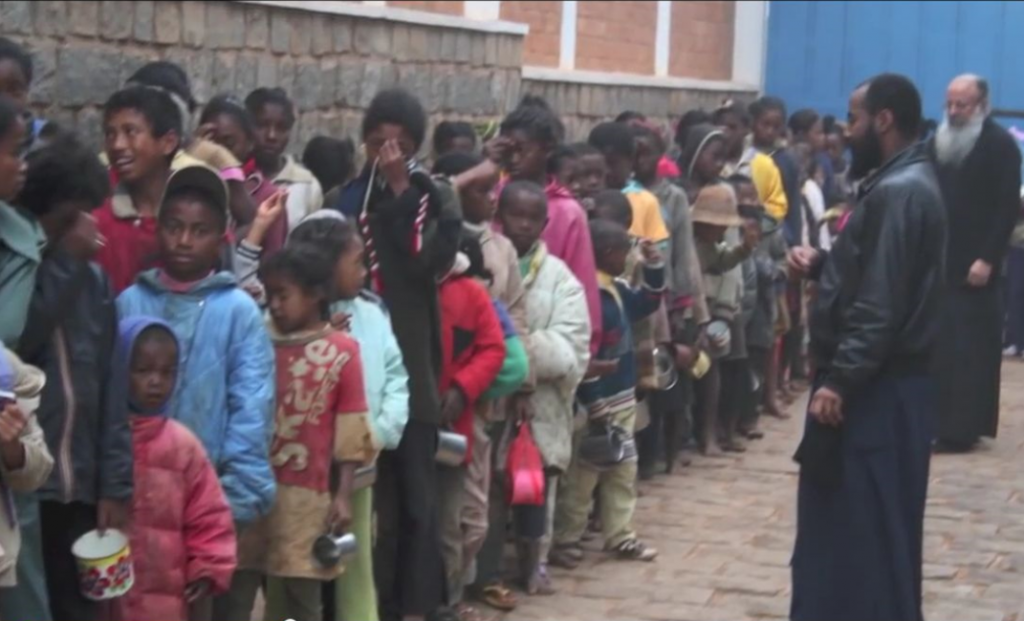I have been having the great good fortune to have a work assignment in Madagascar, which is the world’s fourth largest island, situated off the south-eastern coast of Africa and currently one of the poorest countries in that continent.
The contract I have had is to make five short visits to the country’s capital, Antananarivo (Tana, for short) and I’ve just completed the last visit. With a Sunday to both prepare my work for the next day and to have a bit of time exploring, I have been making walks around the town, including the local Orthodox Church, or Cathedral, in fact.
The local archdiocese or parish has no website, but I managed finally to find an address for the church from a Greek business website. But it told me nothing other than its name (Dormition). I located the address on Google maps and toddled off into the sunshine one Sunday morning. About 1.5km away. Doddle!
Tana is charming but very run-down. Its streets team with ancient Renault 4s, Peugeot 304s and Citroen 2CVs, some in beautiful condition and some rather less so. If you think TinTin and Africa, you just about have the atmosphere of the place. Traditional, locally made brick houses and more modern concrete offices jostle tightly together along winding narrow streets, that climb up and down Tana’s many hills. Little alleys and passageways cut between the buildings giving an air of mystery and secrecy. Yes, a place where Tin-Tin, the famous Belgian comic book boy-detective would indeed be at home.

The atmosphere that I experience is calm, busy, even industrious but very poor. Children’s hands stretch up at you as you pass along the street, seeking alms. Hawkers offer you everything from mobile phone parts, to vanilla pods to finger pianos, in the hope of earning a crust. Some would say it’s not wise for me to tramp the streets, but as a seasoned street wanderer, I don’t feel unsafe. And I get lost. In fact, I go round in circles, at one point coming back round to the same point twice.
There is so much evidence of church life here on this Sunday as there is on every Sunday. As a former French colony, you can see the many Catholic churches, and schools. But, there was British influence here too and an Anglican Cathedral sits close to its Catholic sister on the top of the highest hill, where the vacant royal palaces are. [With little popular regret, the Monarchy was shooed away in 1970.] And, as with so many other African countries, evangelical, Baptist and other churches, often emanating from the USA, have taken hold, offering perhaps a livelier experience of worship that suits some.
By now giving up on my quest to reach the Orthodox Cathedral of the Dormition of the Mother of God, I wander down a short side street which has offices, closed up for the weekend. One of these, I notice is painted blue and white. Oh, there are Greek characters on it! Oh, it’s the entrance to the Orthodox Cathedral. By now, it’s 11:30 and I doubt there’ll be much going on, but perhaps I may catch the end of a service.

As I wander into the entrance court of this office-like structure, I see a crowd of people milling about, all dressed in white shirts, looking fresh and neat. All locals and not a Greek in sight. Parishioners I wonder? I move forward, across an open court-yard, to the entrance of the church, a domed cross-in-a-square church, built of reinforced concrete. A solid, functional and probably not inspiring building. Entering and making the sign of the cross, a young man takes a gentle interest in me and searches discreetly for a couple of candles to put in the candle dispenser for me to buy should, I wish to. The service has clearly ended at some point, but the resonance that one often experiences coming into a church after a service palpably lingers. I intimate that I do want to buy candles and ask him how much. What you want to give, he whispers back. I tell him I’m Orthodox and ask him when the Liturgy starts. 7am he replies, evidently pleased that I’m of the same faith…
The church is quite charming with iconography in a relaxed, almost informal or country style. I take a seat (pews abound!) and spend a few minutes in prayer, regretting my poor sense of direction. As I make my way slowly and reluctantly out of the church, I observe the crowd of people a little more. This is a clinic, I realise. Some are waiting for treatment, drugs or dressings, by a parish room that seems to be used as a clinic, and, n another space, other people surround a man in a white coat, leaning into a small boy’s mouth. I notice he has a pair of pliers – or perhaps they are somewhat more refined than that. Ah, it’s a dentist! Well, I hope he’s a dentist. All somewhat informal, but the boy is sitting still and accepting what might be painful relief from an aching tooth.
So, quietly, calmly and unremarked, this church, our sister church, runs a clinic for its poor parishioners or the surrounding community. I feel quite moved by the thought of it. I want to know more. But today’s not the moment. I wander out and try to remember the street for a future return visit.
With all the rather frightening news from Egypt, it’s easy to imagine that Christianity is assailed from every corner in places like Africa. The opposite is of course the case, and some denominations are exporting African clerics to help fill the gaps left by the collapse in priestly vocations in Europe. But what about Orthodoxy in Africa? We know that one of the ancient patriarchates of the Pentarchy, the Patriarchate of Alexandria, is based (clue’s in the name!) in Alexandria, in Egypt. After centuries of not really bothering about evangelism, except upriver along the Nile, things have now begun to change. If we think of Orthodoxy in modern Africa we are most likely to think of it following the movement of Greek trading families especially along the Eastern side of the continent. But there’s a story hidden here that’s not often told and needs to be understood better. Quietly Orthodoxy has got hold of people, local people, often very poor people, even of whole communities in some places, so that we can now think of Orthodoxy as at least taking its place among the countless denominations in this most spiritual of continents. The current patriarch, Theodoros has not been slow to keep up and to lead the changes, creating dioceses where there were none, ordaining priests and some bishops from amongst the local populations.
Madagascar is part of this story. At this point, I wonder how we can support such positive processes, by our prayer or by our actions. As we contemplate raising money for our own capital appeal, how might we support the development of churches, clinics or schools amongst the emerging Orthodox Christian communities. Emerging just as we are emerging in fact. Or, in our case, re-emerging.
Rdr. Stephen Tierney, Lent 2014